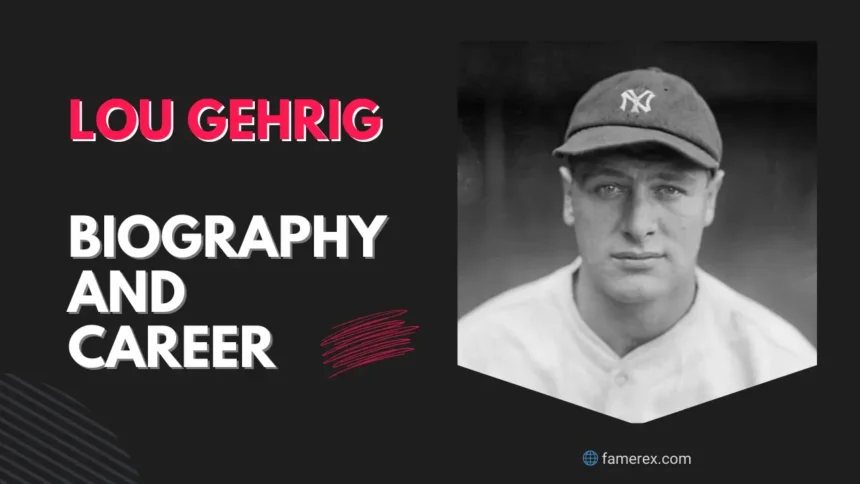Are you familiar with the remarkable story of Lou Gehrig? His legacy transcends sports, embodying courage, resilience, and unwavering determination. As one of baseball’s most iconic figures, Lou Gehrig’s name is synonymous with excellence on the field and grace in the face of adversity.
From his early days as the “Iron Horse” of the New York Yankees to his poignant farewell speech, Gehrig’s journey inspires generations, leaving an indelible mark on the annals of sports history.
Basic Information
| Information | Details |
| Full Name | Henry Louis Gehrig |
| Date of Birth | June 19, 1903 |
| Place of Birth | Yorkville, Manhattan, New York City |
| Height | 6 feet (183 cm) |
| Position | First baseman |
| MLB Debut | June 15, 1923, with the New York Yankees |
| Career Teams | New York Yankees |
| Consecutive Games Streak | 2,130 games (1925–1939) |
| ALS Diagnosis | June 19, 1939 |
| Death | June 2, 1941 (aged 37) |
Introduction
Lou Gehrig, born on June 19, 1903, in Yorkville, Manhattan, left an indelible mark on baseball history. His legacy goes beyond the field, defining resilience, sportsmanship, and philanthropy. Let’s unravel the story of the Iron Horse and its enduring impact.
Early Life and Background
Growing up in New York City, Lou Gehrig’s introduction to baseball paved the way for a remarkable journey. His collegiate baseball career at Columbia University foreshadowed the greatness he would achieve in the major leagues.
Rise to Baseball Stardom
Joining the New York Yankees in 1923, Gehrig quickly became an integral part of the team. His consistency, power-hitting, and stellar defense contributed to the Yankees’ success during the “Murderers’ Row” era, forming a legendary duo with Babe Ruth.
Record-Breaking Achievements
Gehrig’s consecutive games played streak—2,130 games over 17 seasons—is one of baseball’s most enduring records. His offensive prowess and numerous accolades solidified his status as one of the greatest hitters in the sport’s history.
Relationship with Babe Ruth
The dynamic partnership between Gehrig and Babe Ruth fueled the Yankees’ dominance. Their camaraderie on and off the field and their remarkable individual achievements defined an era in baseball history.
Off the Field: Personal Life
Beyond the baseball diamond, Gehrig’s personal life included philanthropic efforts and charitable contributions. Despite facing personal struggles, Gehrig remained dedicated to making a positive impact on the lives of others.
The Diagnosis and “Luckiest Man” Speech
Gehrig’s life took a poignant turn when he was diagnosed with Amyotrophic Lateral Sclerosis (ALS) on his 36th birthday in 1939. His farewell speech at Yankee Stadium, expressing gratitude and resilience, remains iconic in sports history.
Legacy and Impact
Lou Gehrig’s legacy extends beyond the record books. His courageous battle with ALS raised awareness of the disease, and the annual Lou Gehrig Day in baseball continues to honor his memory. Posthumous honors, including the renaming of the prestigious Most Valuable Player (MVP) award, underscore his lasting impact.
Cultural Influence
Gehrig’s story has been immortalized in literature, film, and documentaries, reflecting the enduring fascination with his life and career. His image as the Iron Horse endures as a symbol of perseverance and dedication.
Conclusion
In conclusion, Lou Gehrig’s impact on baseball and society transcends statistics. The Iron Horse’s unwavering commitment to the game and his grace in the face of adversity cements his place as a legend. Lou Gehrig’s legacy is a timeless reminder of the power of sportsmanship and resilience, leaving an everlasting imprint on the heart of America’s pastime.
FAQs
- Who was Lou Gehrig?
- Lou Gehrig was an American professional baseball first baseman known for his legendary career with the New York Yankees, earning the nickname “the Iron Horse” for his durability and exceptional hitting prowess.
- What made Lou Gehrig famous?
- Lou Gehrig gained fame for his remarkable durability, playing in a record-setting 2,130 consecutive games, and his exceptional batting skills, solidifying his status as one of baseball’s all-time greats.
- What were Lou Gehrig’s nicknames?
- Lou Gehrig was affectionately known by several nicknames, including “the Iron Horse,” “Buster,” “Hungry Lou,” and simply “Lou,” reflecting his strength, determination, and enduring legacy in baseball.
- When did Lou Gehrig join the New York Yankees?
- Lou Gehrig joined the New York Yankees on June 15, 1923, marking the beginning of a storied career that would make him one of baseball’s most iconic figures.
- How tall was Lou Gehrig?
- Lou Gehrig stood at a height of 1.83 meters (approximately 6 feet), towering over opponents on the baseball diamond as he showcased his exceptional talents as a first baseman and pinch hitter.
- How old was Lou Gehrig when he passed away?
- Lou Gehrig tragically passed away at the age of 37 on June 2, 1941, leaving behind a lasting legacy in the world of baseball and beyond.
- Who was Lou Gehrig’s spouse?
- Lou Gehrig was married to Eleanor Gehrig, and their union lasted from 1933 until his untimely death in 1941. Eleanor remained a devoted advocate for ALS research following her husband’s diagnosis of the disease.









